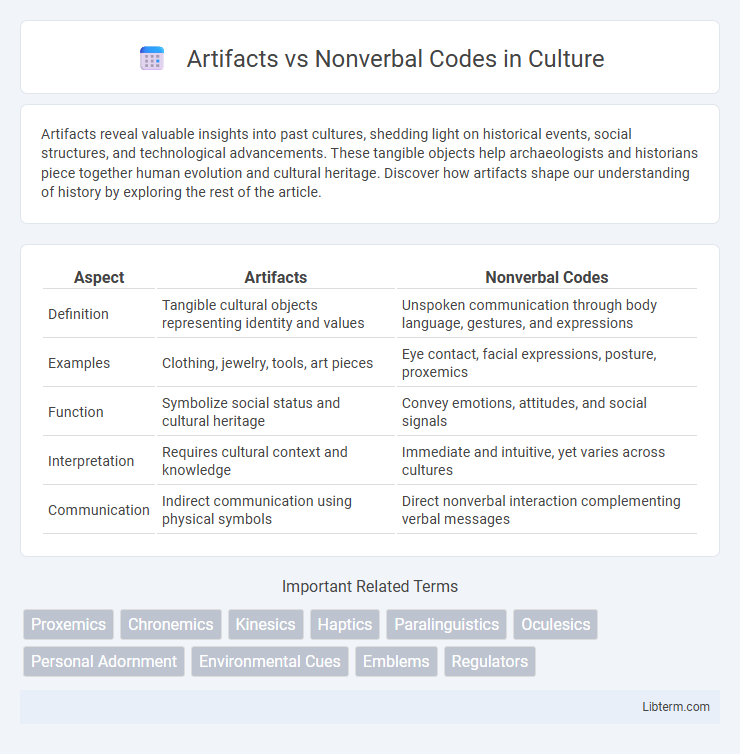Artifacts reveal valuable insights into past cultures, shedding light on historical events, social structures, and technological advancements. These tangible objects help archaeologists and historians piece together human evolution and cultural heritage. Discover how artifacts shape our understanding of history by exploring the rest of the article.
Table of Comparison
| Aspect | Artifacts | Nonverbal Codes |
|---|---|---|
| Definition | Tangible cultural objects representing identity and values | Unspoken communication through body language, gestures, and expressions |
| Examples | Clothing, jewelry, tools, art pieces | Eye contact, facial expressions, posture, proxemics |
| Function | Symbolize social status and cultural heritage | Convey emotions, attitudes, and social signals |
| Interpretation | Requires cultural context and knowledge | Immediate and intuitive, yet varies across cultures |
| Communication | Indirect communication using physical symbols | Direct nonverbal interaction complementing verbal messages |
Understanding Artifacts and Nonverbal Codes
Artifacts are tangible objects such as clothing, jewelry, and personal belongings that communicate identity, status, and cultural values nonverbally. Nonverbal codes include kinesics (body language), proxemics (personal space), haptics (touch), and chronemics (time use), which collectively convey emotions, intentions, and social norms without spoken words. Understanding the distinct roles of artifacts and nonverbal codes enhances interpretation of social interactions and cultural communication patterns.
Defining Artifacts in Communication
Artifacts in communication are physical objects or environmental features that convey messages nonverbally, such as clothing, jewelry, or personal belongings. These items symbolize identity, status, and cultural affiliation, influencing how individuals are perceived in social interactions. Unlike verbal language, artifacts provide contextual cues that shape interpretations and emotional responses without spoken words.
The Scope of Nonverbal Codes
Nonverbal codes encompass a broad spectrum of communication methods beyond artifacts, including kinesics, proxemics, haptics, chronemics, and paralanguage, each governing different aspects of human interaction. These codes regulate interpersonal behavior through body language, spatial distance, touch, time management, and vocal characteristics, providing nuanced layers of meaning in social exchanges. Unlike artifacts, which are physical objects symbolizing identity or status, nonverbal codes operate dynamically in real-time interactions to convey emotions, intentions, and relational cues.
Key Differences Between Artifacts and Nonverbal Codes
Artifacts are tangible objects used to convey messages or symbolize cultural meaning, such as clothing, jewelry, or personal belongings, whereas nonverbal codes encompass a broader range of communicative behaviors including gestures, facial expressions, posture, and proxemics. Artifacts serve as static symbols that reflect identity or social status, while nonverbal codes involve dynamic interactions that regulate communication and express emotions. The key difference lies in artifacts being physical items with symbolic value, whereas nonverbal codes consist of physical behaviors that function as systematic language within social contexts.
Cultural Influence on Artifacts and Nonverbal Codes
Artifacts and nonverbal codes are deeply shaped by cultural contexts, reflecting societal values, beliefs, and norms through tangible objects and nonverbal communication patterns. Cultural influence determines the meaning and interpretation of artifacts such as clothing, jewelry, and architecture, while nonverbal codes like gestures, proxemics, and facial expressions vary significantly across cultures, signaling different social messages and emotional cues. Understanding these cultural variations is essential for effective cross-cultural communication and avoiding misinterpretations in diverse social settings.
The Role of Artifacts in Identity Expression
Artifacts play a critical role in identity expression by serving as tangible symbols that convey personal values, cultural affiliations, and social status. Objects such as clothing, jewelry, and personal belongings function as nonverbal codes that communicate messages without words, reflecting an individual's personality and group membership. The choice and display of artifacts enable individuals to assert their identity and influence perceptions within social interactions.
Nonverbal Codes in Everyday Interactions
Nonverbal codes, including facial expressions, gestures, posture, and eye contact, play a crucial role in everyday interactions by conveying emotions, attitudes, and social cues without spoken words. These codes often regulate conversation flow, signal agreement or disagreement, and enhance message clarity in interpersonal communication. Understanding nonverbal cues helps improve empathy, build rapport, and avoid misunderstandings in social and professional contexts.
Artifacts vs Nonverbal Codes: Impact on Perception
Artifacts such as clothing, jewelry, and personal accessories serve as tangible nonverbal codes that significantly influence perception by signaling social status, cultural identity, and personality traits. Unlike other nonverbal codes like gestures or facial expressions, artifacts provide a persistent and easily interpretable visual cue that shapes first impressions and ongoing social interactions. The strategic use of artifacts enhances communication by reinforcing intended messages and mitigating ambiguities inherent in more transient nonverbal signals.
Interpreting Artifacts and Nonverbal Signals
Interpreting artifacts involves analyzing personal objects such as clothing, jewelry, and decor to understand cultural identity, social status, and individual personality. Nonverbal signals like facial expressions, gestures, posture, and eye contact convey emotions and intentions that often complement or contradict spoken language. Accurate decoding of both artifacts and nonverbal cues enhances communication effectiveness by providing deeper context to verbal messages.
Enhancing Communication Through Artifacts and Nonverbal Codes
Artifacts such as clothing, accessories, and personal belongings convey identity and influence first impressions, enhancing communication by providing visual context and reinforcing verbal messages. Nonverbal codes, including gestures, facial expressions, and posture, express emotions and regulate interactions, creating a richer and more nuanced understanding in conversations. Combining artifacts with nonverbal cues effectively supports message clarity, builds rapport, and fosters deeper interpersonal connections.
Artifacts Infographic

 libterm.com
libterm.com